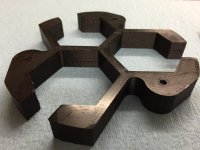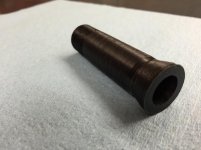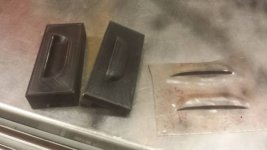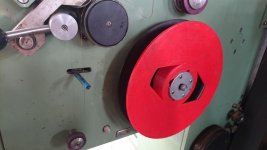I thought I would post a few examples of a extremely boring components to throw up here, hopefully to get the ball rolling and see what others use their printers for. Note to the people who want to hang crap on seemingly everything, these are NOT examples of good prints, quite the opposite in some cases. Instead just "stuff I've made" that I just quickly went to the workshop and could see handy to photograph.
The first was an indicator holder so I didn't need to fuss about getting a mag base. It's a friction fit in the toolpost so I just drop it on and indicate a part as required. It was printed in ABS but the shape made it shrink, I could do it again with more care if I cared. I don't so won't. It works fine as it is.

I needed a 5 degree platter as a fixture to hone the edges of scraper blades. I wasn't going to dick about with the mill as I have better things to do with my time. Sent it to the printer and this is what I got.
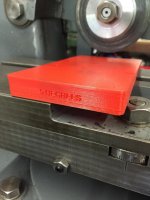
This is a radius gauge I quickly drew up so I didn't risk trashing my good radius gauges on trivial work around the T&C grinder. The centre is a 1" square if I ever feel like counting dots. Unlikely but who knows. I thought I'd send some down to a friend who may be able to use them or give them out to scraping students, so threw his name on it. The orange ones are PLA.

The final one is obviously a T-slot cleaner, I can't recall what that one was printed in, but probably PLA. Does what it says on the packet.

Again, these are not supposed to be examples of great prints. Instead just mundane hacks that I could get the printer to do while I was busy with something else, 3 of them I'd do again if they were going to somebody else or it mattered. Also some were from fairly early days, and with time both my own, and the printer's abilities, continue to improve, so chances are most of the printing now is better. But it didn't matter and I just ran with them as they popped off the printer bed.
I'll try to put up some more as I think about it or see them around the workshop, and hope others will do so too. Just useful "stuff". Goodness knows it makes a change from endless "vases" or bowl that is all I ever seem to see put up about 3D printers.






